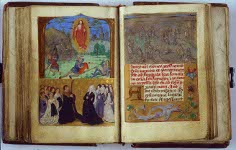Book of Hours with prayer portraits of a Jerusalem pilgrim
| General information | |||||||||||||||||||||||||||||||
| Original location | Bruges (based on residence of the sitter). Even if identification is incorrect, stylistic features point to the Bruges/Ghent area | ||||||||||||||||||||||||||||||
| Current location | Stockholm, Kungliga biblioteket, MS A233 | ||||||||||||||||||||||||||||||
| Artist | Anonymous | ||||||||||||||||||||||||||||||
| Date | Before 1516 (year of death of Jan de Trompes) | ||||||||||||||||||||||||||||||
| Material | Manuscript on vellum | ||||||||||||||||||||||||||||||
| Dimensions | 10,2 x 7 cm | ||||||||||||||||||||||||||||||
| Visual elements | |||||||||||||||||||||||||||||||
| Short description | Book of Hours, containing several miniatures with devotional portraits of a Jerusalem pilgrim. ff. 56v-57v (before the penitential psalms): Crucifixion (56v) with prayer portrait (57r), half-length, looking in the direction of, but not directly towards, the opposite scene. Behind the sitter stands John the Baptist, in the painted frame is a small scene with the baptism. On the back of the leaf (57v) the Last Judgment with scenes around it: top left the heavenly Jerusalem, under it an angel taking the soul of the pilgrim out of purgatory, on the bottom border St Michael driving souls into the mouth of Hell. The soul of the pilgrim (carrying a palm, wearing only a loincloth, by which he is recognizable from the other depicted souls, who are fully nude) stands in the bottom left corner, watching the scene. f. 86v (before prayers to be said in the church of the Holy Sepulchre): Resurrection of Christ. Under the scene in a separate frame a kneeling family, ten male members on the viewer's left, nine female members on the right. The father of the family, depicted first left from the middle, carries a palm. f. 103 (before the Hours of the Cross): Betrayal of Christ (103r), the kneeling pilgrim displayed full-length with St John the Baptist watching from an architectural painted niche with a pedestal on the viewer's right. On f. 103v the Lamentation, in the architectural gothic border a skull under the scene, and to the right of it the praying pilgrim, displayed half-length, facing the scene, once again accompanied by John the Baptist. f. 107v (before the Hours of the Holy Spirit): Pentecost in a small building in front of a city scape. To the left, displayed in another small building, the praying pilgrim, displayed half-length, looking to the depicted scene. On the bottom of the page under an arch a bird with a long beak pecking at the eyes of a dog. |
||||||||||||||||||||||||||||||
| Number of pilgrims | 2 | ||||||||||||||||||||||||||||||
| Depicted pilgrims (from left to right) | |||||||||||||||||||||||||||||||
| |||||||||||||||||||||||||||||||
| Additional information | |||||||||||||||||||||||||||||||
| General remarks | The inclusion of prayers to be read in the church of the Holy Sepulchre (ff. 87r-95r) and the church of the Nativity in Bethlehem (ff. 97r-101r), together with the recurrent inclusion of the pilgrim's portrait in the miniatures, makes it likely that the manuscript was made as a very richly decorated vademecum, a book to be taken on pilgrimage. In this case, as Rudy suggests, the inclusion of the portraits of his family members may come from the idea that they would travel virtually with him to Jerusalem. This is not very probably, though, if only given the dangers of the journey, with high risks of robbery and kidnapping, which would make theft of such a luxurious book a highly possible danger. Therefore, other possible motives would be more likely. The pilgrim may have had the book made to commemorate his pilgrimage after he came back, or never have gone at all, for example because an untimely death prevented him from doing so. Whether he went or not, the book could also have functioned as a spiritual pilgrimage, which could have the same effect on one's soul as a 'real' pilgrimage. Folio 57 differs slightly in style, and is probably added a bit later. |
||||||||||||||||||||||||||||||
| Literature |
|
||||||||||||||||||||||||||||||







